At The Independence, we have fallen in love with Dayna Collins’ work and we feel so lucky to have several of her pieces displayed throughout the hotel. Her work is bold, energetic and joyful, while also drawing you in with evocative layers and rich textures. More than once, we’ve come across guests gazing up at her work, having “a moment” and getting lost in the art.
Because we love getting lost in her work, we were beyond thrilled to interview Dayna about her life and her art.
In addition to The Independence Hotel, you can find Dayna’s work by visiting her website or checking out her delightful Instagram. Her work is at three galleries in Oregonian (Salem on the Edge, RiverSea Gallery in Astoria, and Guardino Gallery in Portland), and she currently has a show, Turn of the Kaleidoscope at Salem on the Edge (just a short driver from the Hotel) through May, 2021.
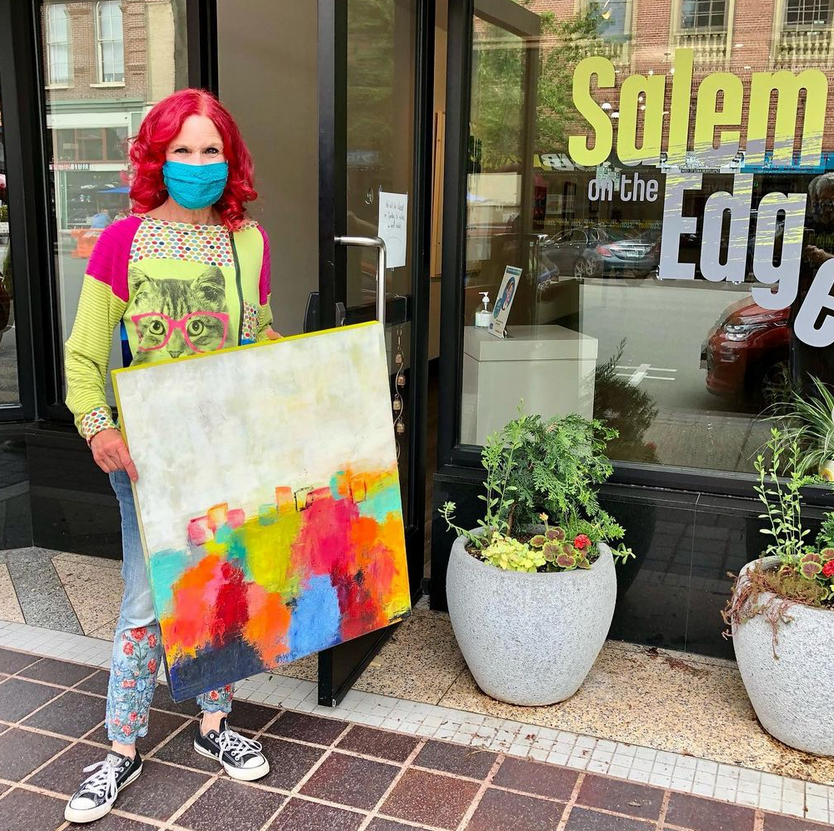
Dayna’s show, Turns of the Kaleidoscope is showing during May, 2021 at Salem on the Edge in Salem.
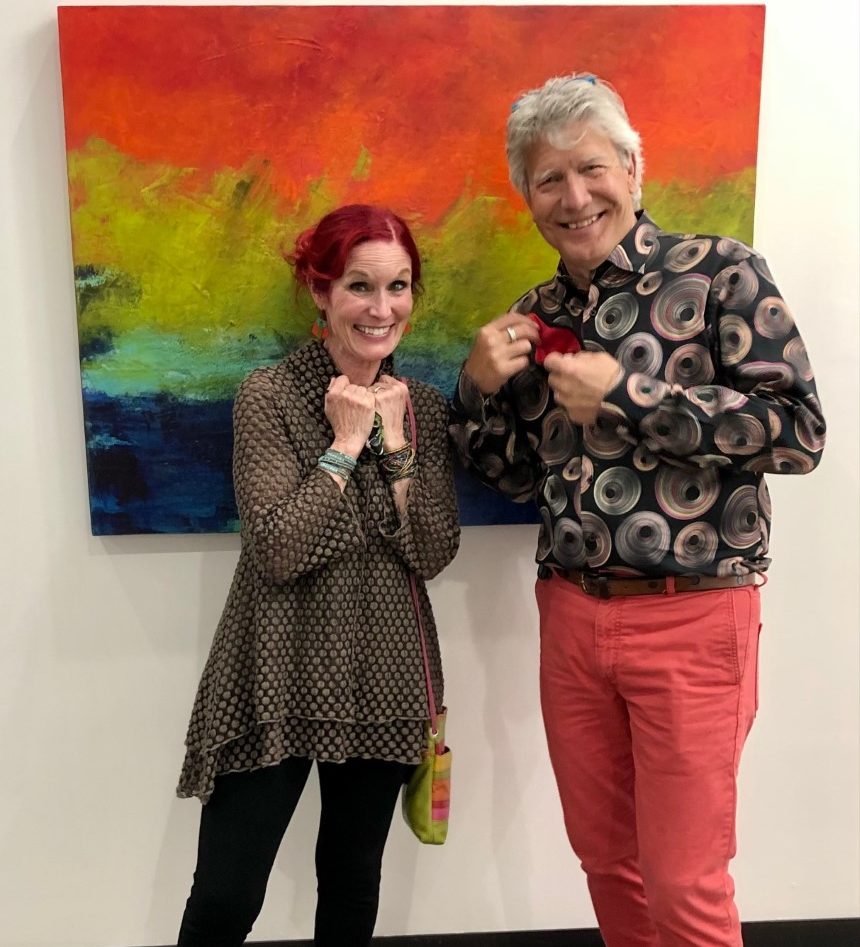
Dayna and Howard (Husband, Business Manager, Partner in Color Exploration) at the opening reception for Turn of the Kaleidoscope.
Independence Hotel (IH) What is your background when it comes to art? What made you want to become an artist?
Dayna Collings (DC) My art and life has been an evolution of color and represents a rise out of darkness. Twenty-one years ago after entering recovery for addiction, I discovered I was an artist while taking a 12-week course on creative recovery. My first art was collage – on bowling pins. A whole new world opened for me and I knew I wanted to paint, explore texture, and experiment with putting bold, vibrant colors together.
IH: What inspires you? (Currently, as I’m guessing it probably changes with time.)
DC: In my years of journaling and writing, the words that describe my inspiration appear again and again: Texture, history, layers, intersections, swaths, mystery, playful, remnants, transformation, excavation, color . . .these are the things that inspire me.
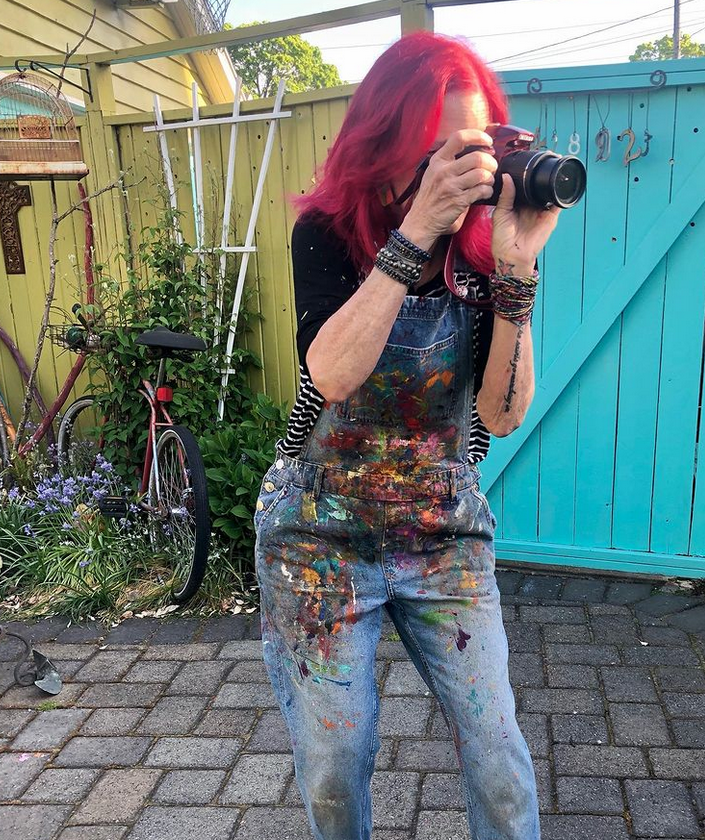
With an eye of an artist, Dayna seems to find inspiration everywhere.
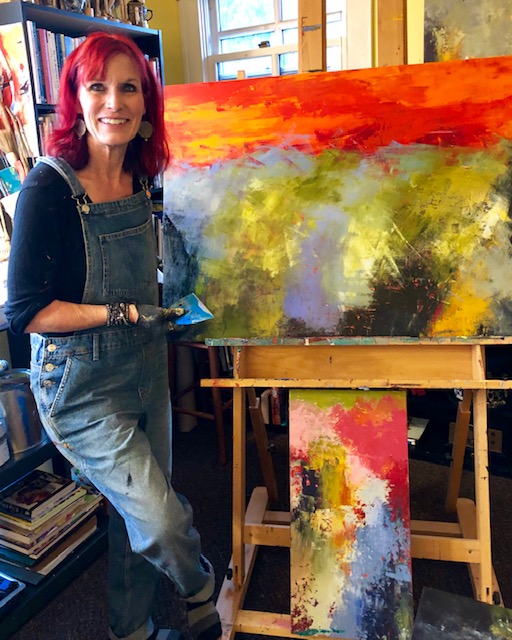
Dayna creating one of the pieces for The Independence Hotel
IH: What does your work aim to say (or perhaps even more importantly, feel)?
DC: Joyful, playful, sassy, irreverent, light, funky, energetic, free, vivid, wild. These are the words that I associate with the color in my life. They appear in my art and in my life; they are reflected in my fiery red hair, my multi-colored bracelets, my numerous tattoos, my avant-garde clothing, my crazy green boots and my Chuck Taylor All-Star Converse tennis shoes.
IH: Would you say your work comments on current social or political issues, or would you say you lean towards escapism and other worlds? (Or both/neither?)
DC: Current social and political issues influence the flavor, color, and intensity of my art, but I do not create pieces generally as a response or to take a position. An exception was a show in January of this year at RiverSea Gallery in Astoria; the show was titled “Emotional Alignments,” and it was a show created entirely as a response to what was happening in 2020. An excerpt from my Artist Statement:
Painting got me through the roller coaster of 2020. As I painted during the pandemic and the mounting death toll, amidst a divisive political climate, racial inequality protests, devastating wildfires, and personal traumas that kept hammering my family, I painted. I applied plaster to boards and spread layer after layer of oil paint mixed with cold wax. These sensuous, tactile materials allowed me to explore color, texture, intersections, to lay down paint, draw into it, scrape it away, add another layer, and yet see the history of earlier layers, marks, and color.
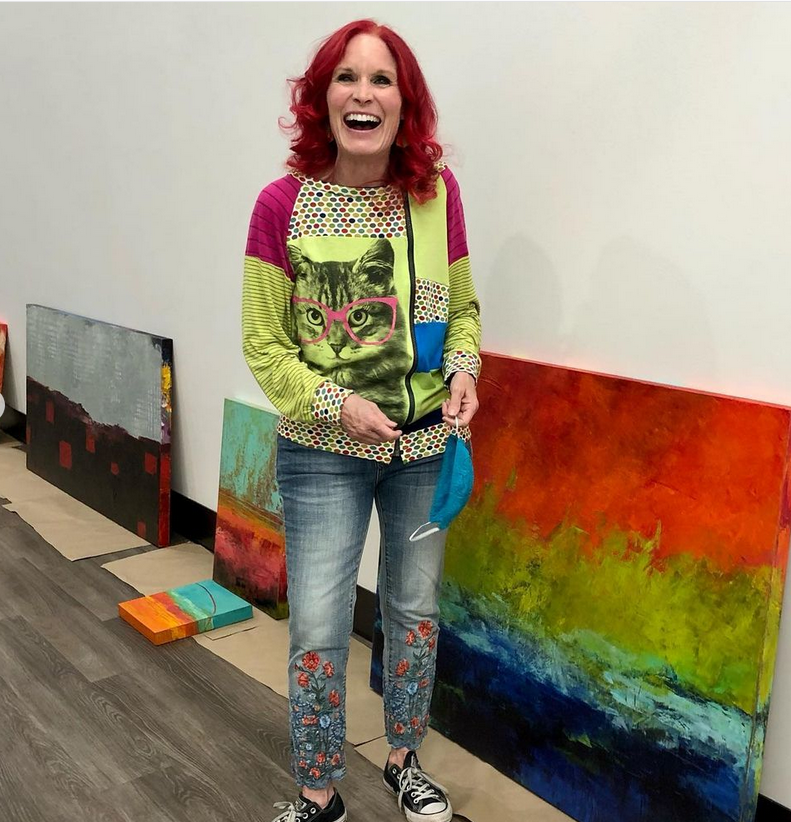
Dayna prepares for her show at Salem on the Edge
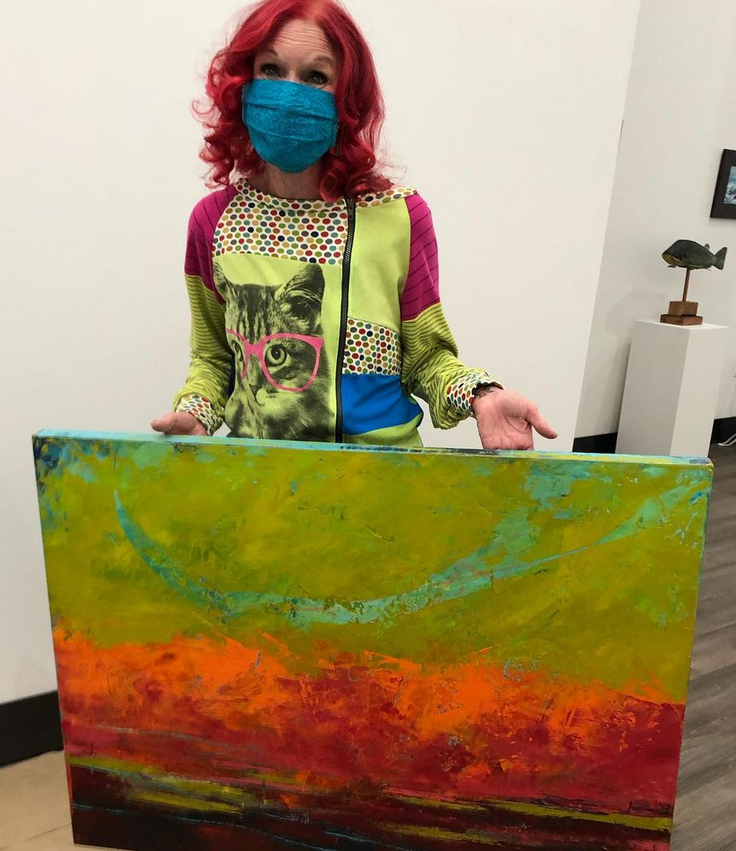
Dayna shows one of several in her collection showing at Salem on the Edge
IH: Who are your biggest influences?
DC: Joan Mitchell, Helen Frankenthaler, Richard Diebenkorn, Brian Rutenberg, Mark Rothko, Lee Krasner, Elaine de Kooning, Antoni Tapies, Robert Motherwell, Jasper Johns, Robert Rauschenberg, Franz Kline, Willem de Koonig, Cy Twonbly . . . . to name a few!
IH: What habits do you find help (or hinder) creativity?
DC: I nurture my creativity on a daily basis by incorporating rituals throughout the day that influence my art (and life). I start my day with a latte and reading from a book on some kind of creativity. Currently I am reading about a color a day from “The Secret Lives of Color” by Kassia St. Clair. My day always involves a walk, sometimes several walks. Visiting Instagram to see what other artists are doing is always inspirational for me. I try and get to my studio in some way every day, whether to tidy things up, or to jot an idea in my visual journal. Sometimes by dong a small thing, I end up staying and working on a project.
IH: Do you plan out ideas ahead of time, or does spontaneous inspiration take over?
DC: I work intuitively, enjoying the process of putting things together in random and unexpected ways. Abstract landscapes seem to find their way into my work, but other than a landscape orientation, I let the colors take me on the journey. One of my techniques is scraping and excavating and there is no way to plan ahead for where that will lead me (see description of Baffled Amazement below).
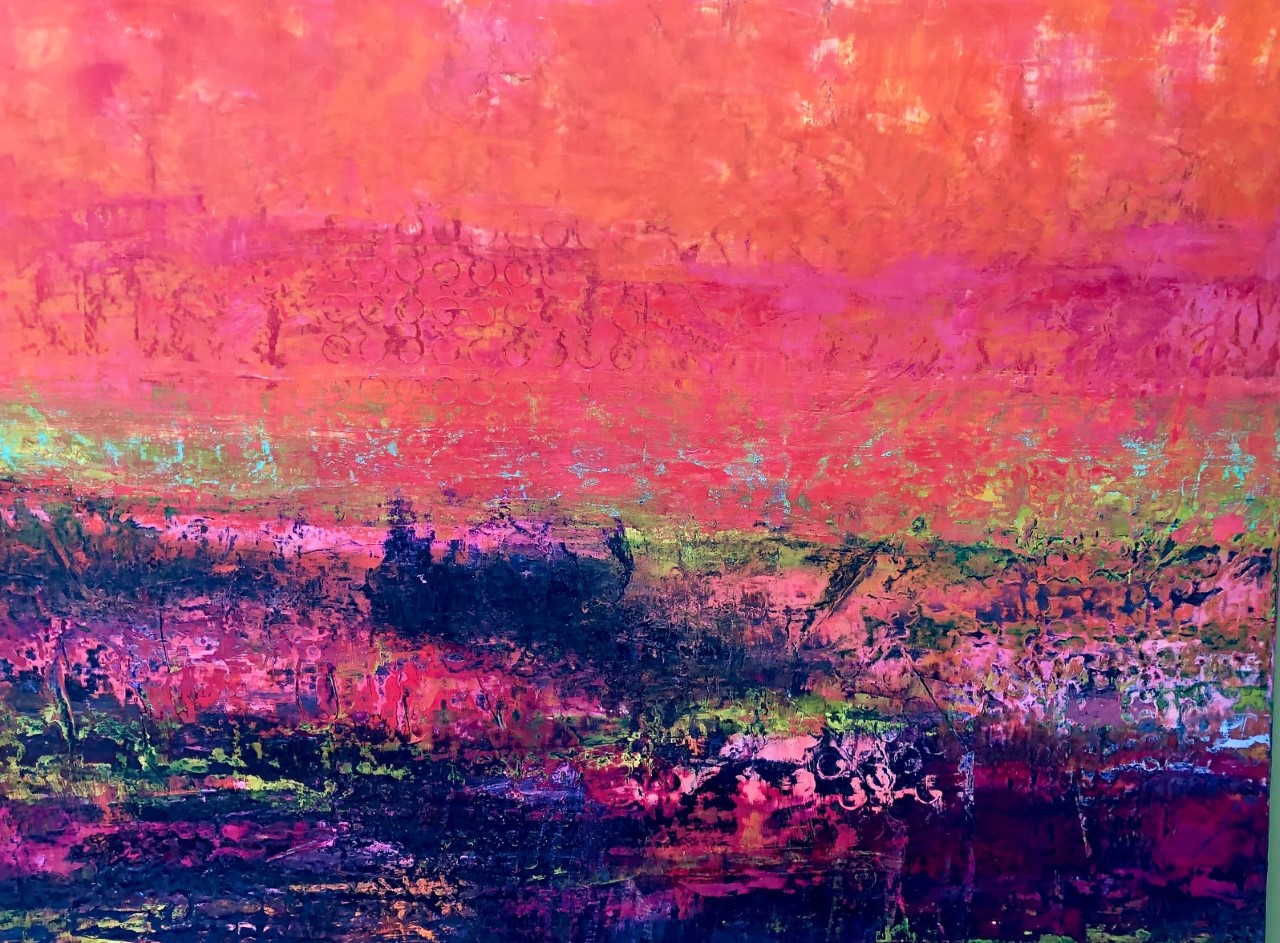
Photo of Dayna’s work Baffled Amazement and her description of the process: “Baffled Amazement, a 36×48 inch piece that was giving me grief. There were multiple layers of oil and cold wax (over plaster), but nothing seemed to be working. In frustration, I took a spray bottle of solvent, soaked the lower portion, then began scraping off thick layers of paint. Much to my surprise and delight, all the layers of paint had deposited colors in the crevices, and a very interesting surface emerged. This painting is now in my current show at Salem on the Edge, Turns of the Kaleidoscope.”
IH: What is the earliest memory you have of creating art?
DC: I think I was in third grade in Portland when student created a book of all the bridges in the city. We learned about the different kinds of bridges and to draw each one. I sure wish I had that book now. My next memory was taking an art class in high school and I created a mosaic of a king and a queen; the king hangs in my daughter’s house in Portland.
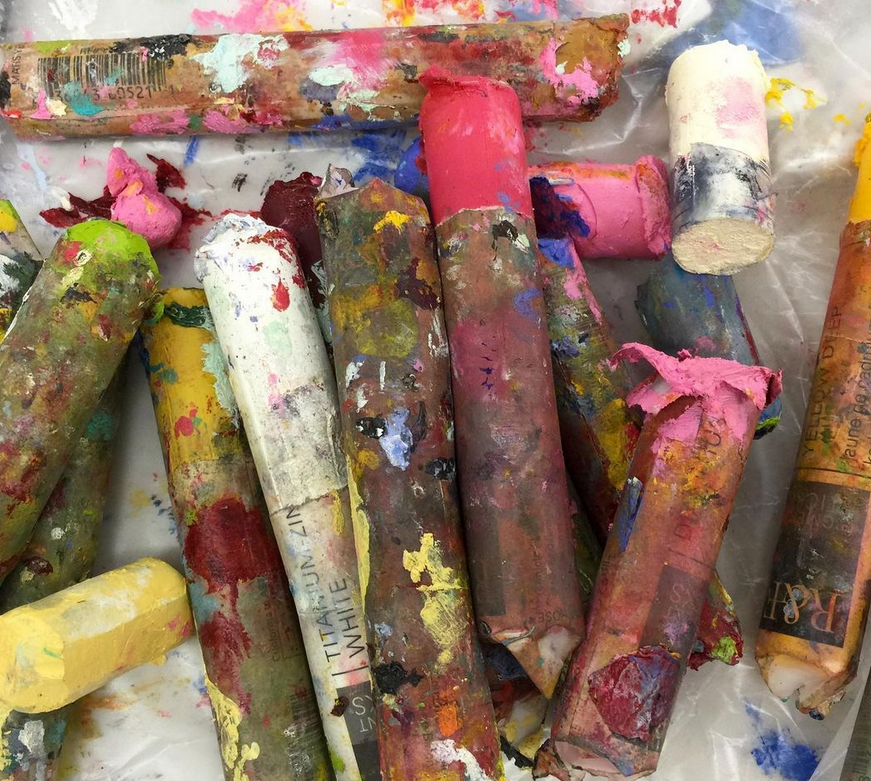
The right tools for the job!
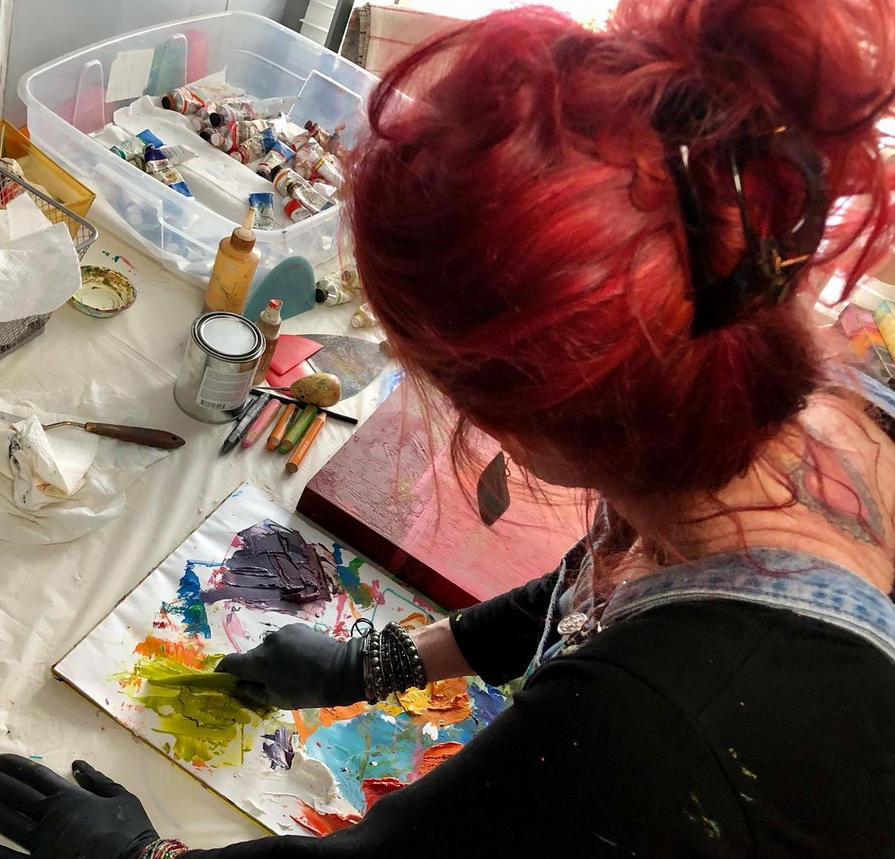
Dayna in creation mode!
IH: If you could describe your approach to art in 5 words, what would they be?
CM: Joyful, playful, sassy, irreverent, light, funky, energetic, free, vivid, wild. I guess I used 10 words. Oops.
IH: What’s the best piece of advice you’ve ever been given as an artist?
CM: Many years ago when my husband and I were planning our first visit to New York City, and we were feeling a bit apprehensive and a friend told us to BE BOLD. That really stuck with me and although the advice wasn’t specific to making art, it has been mantra in art and life ever since.
IH: What is one tool you couldn’t live without?
CM: I sure like wandering around hardware stores and my favorite tools are putty knives – the bigger the better, because when I use big tools, my work has less control and more looseness.
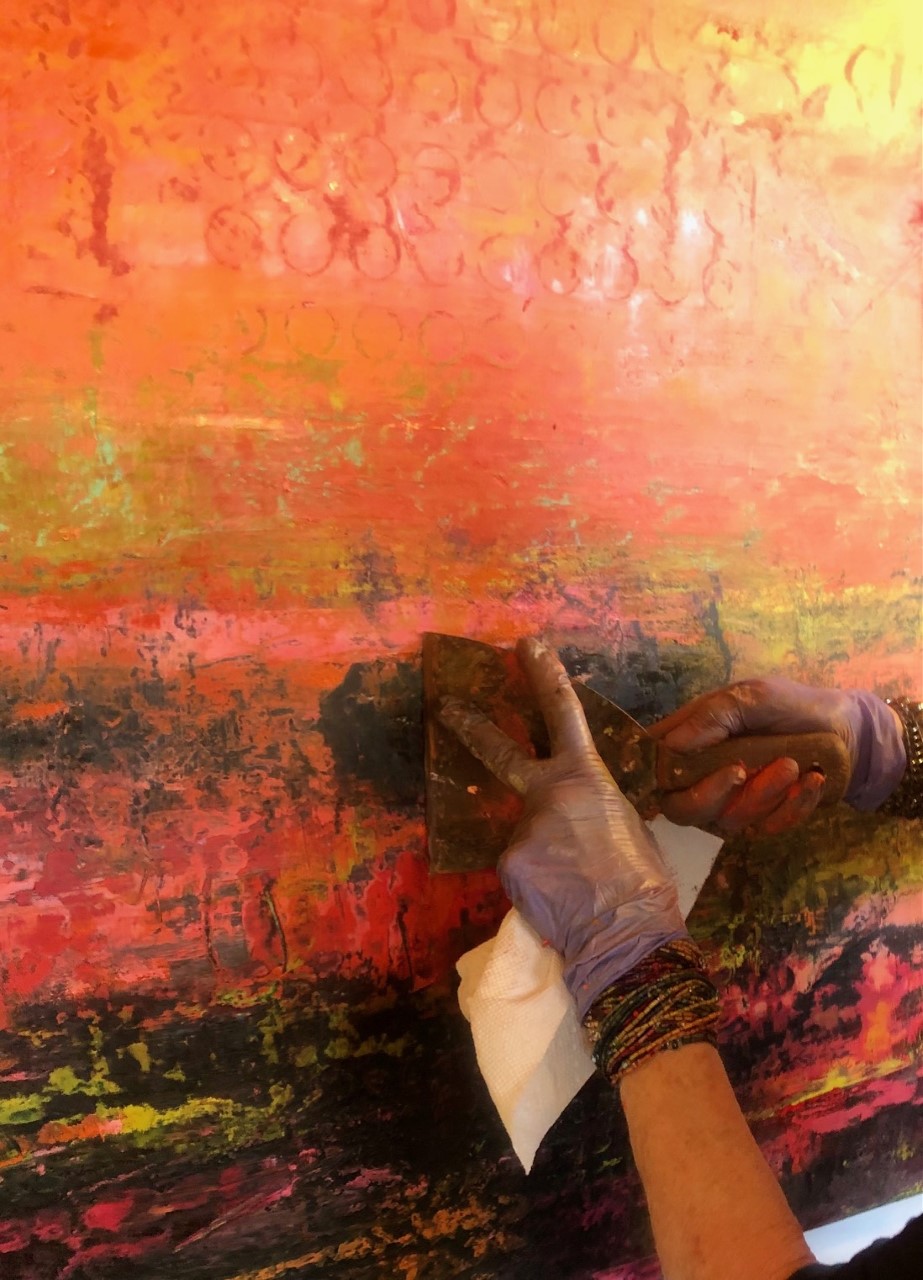
Layers for days
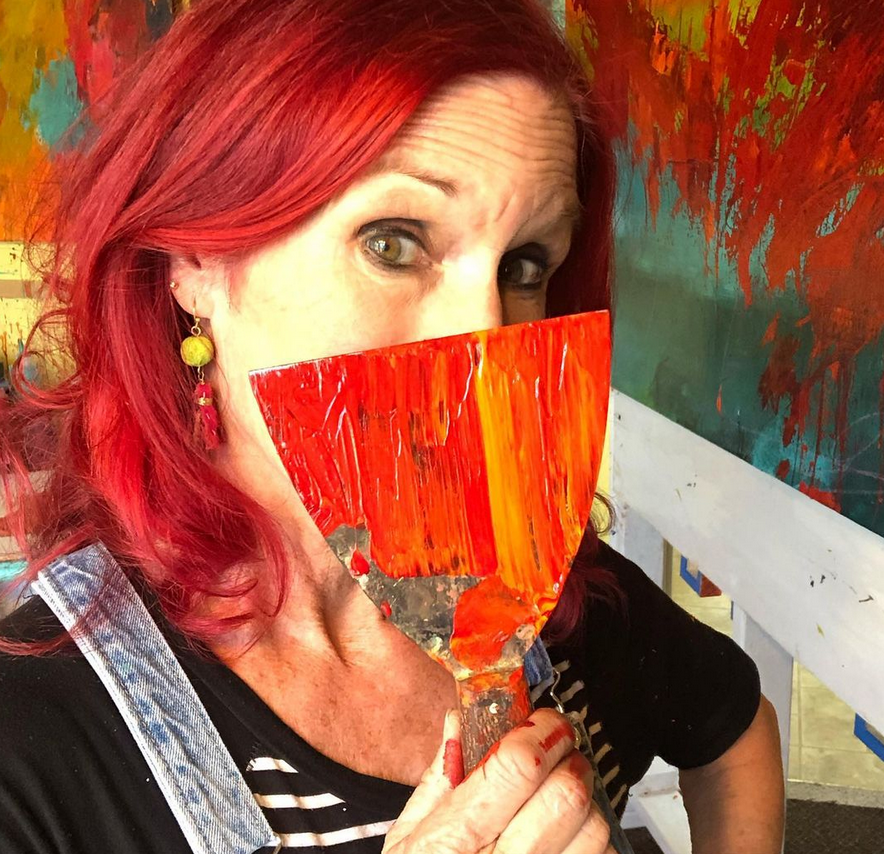
Just an artist with her putty knife, great things are about to happen!
IH: I see on your website that you teach workshops. How cool! What is your favorite part about teaching art?
DC: There are so many things about teaching that I love. I love the preparation, of planning the best experience possible for my students. Everything from the handouts I create, to the quotes I read through each day of teaching. I don’t love doing demos, but once I have done a demo, I love walking around and helping my students integrate the new techniques or help them solve problems.
IH: I really adore your titles. “It Smelled Like the End of Summer,” “A State of Constant Transition,” “The Emporium of Small Delights,” etc. What comes first, the title or the piece? And how do you go about naming them?
Titling art is one of my favorite things and I recently did an entire blog post about my process! Here is an excerpt:
I am often asked how I come up with the titles for my paintings, so I’m going to spill the beans. Whenever I’m reading a beautifully written novel, I keep a piece of paper and a pen handy to jot down portions of sentences or phrases that resonate with how the words are put together. I do the same when I am reading poetry, just taking a few of the words, or “word fragments,” and scribbling them on a scrap of paper. I keep all of my pieces of paper gathered together on a clipboard, which I then refer to when it is time to name a painting.
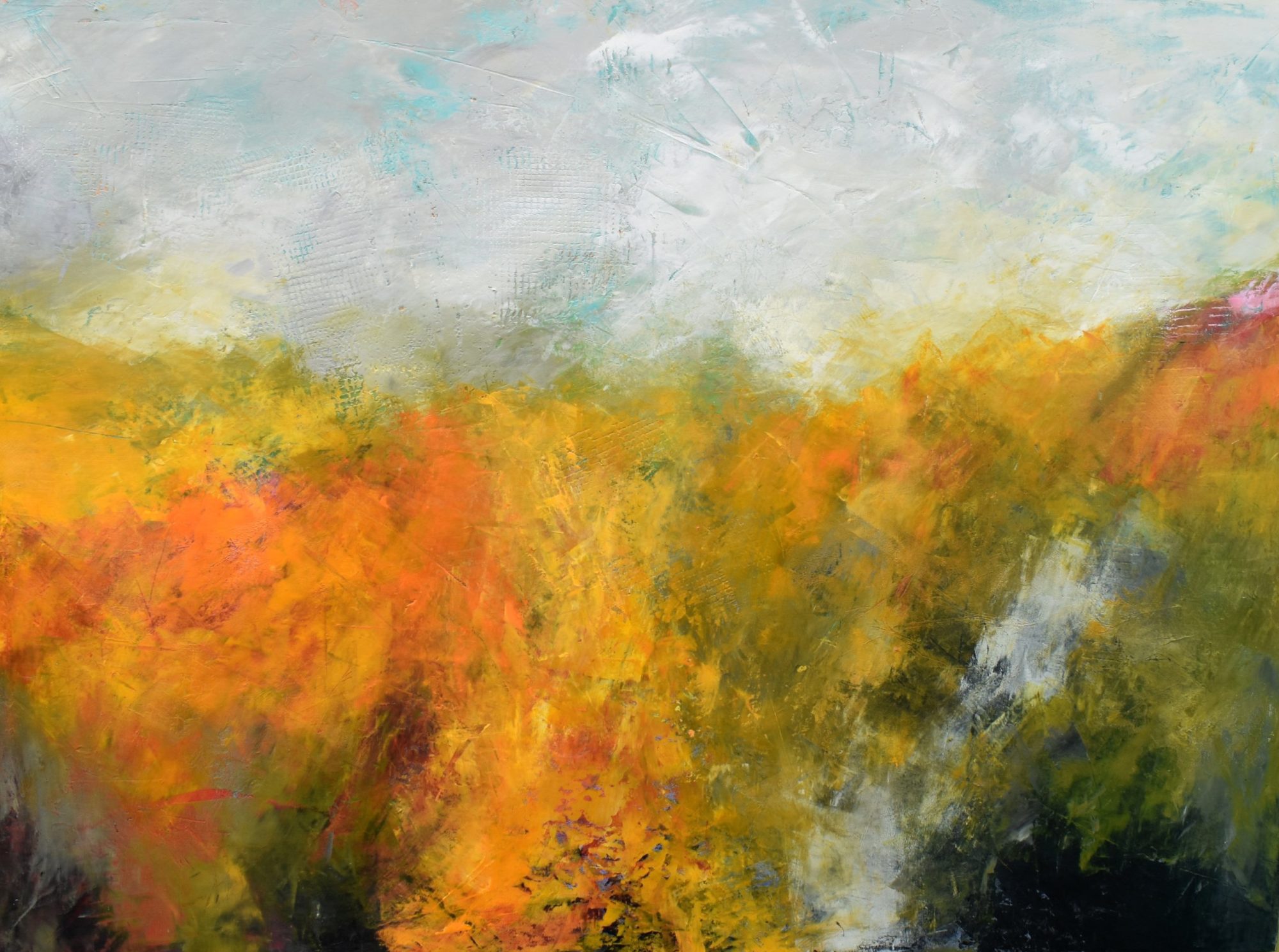
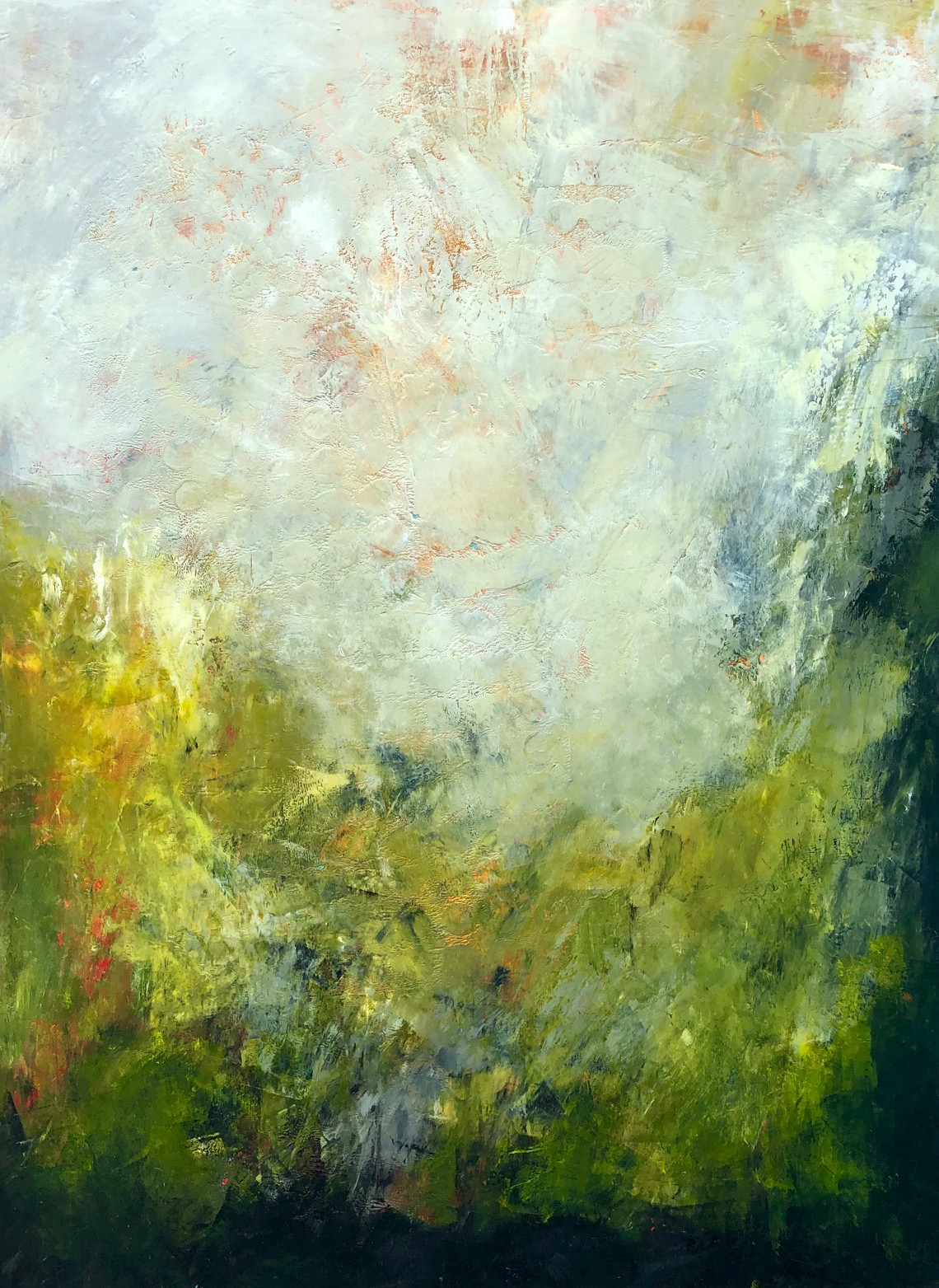
Two pieces hanging at the Independence: It Smelled Like Summer (left) and Remnants of Morning Mist (right).
IH: Do you have a favorite piece at The Independence? (Mine is “Remnants of Morning Mist.” There is something about it that encourages me to take a deep breath, and to honor what the mist/rain brings to us here in the PNW. Such as life, greenery, and the constant reminders that we are so much bigger than our own perceptions of ourselves.)
DC: That piece, “Remnants of Morning Mist,” is one of my favorites, too. I remember painting it, and how it seemed to paint itself as I built up from dark to light and your description of how it makes you feel is beautiful.
IH: How did you decide which pieces to send to The Independence?
DC: It was a very different process for the pieces that went to The Independence. I painted three very specific pieces with the hotel’s location in mind. Knowing that the hotel was on the river, I wanted to create abstracted landscapes to fit the beautiful, natural scenery.
IH: When you lend artwork to a hotel or gallery, what is your role in how it’s placed?
DC: I was not involved with the placement – I like making art and leaving the placement to the experts in that area.
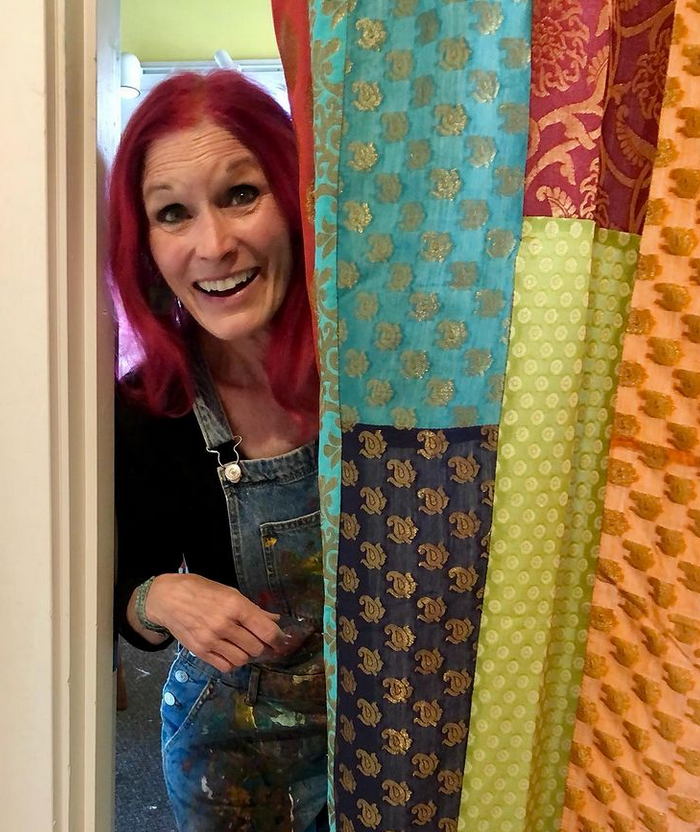
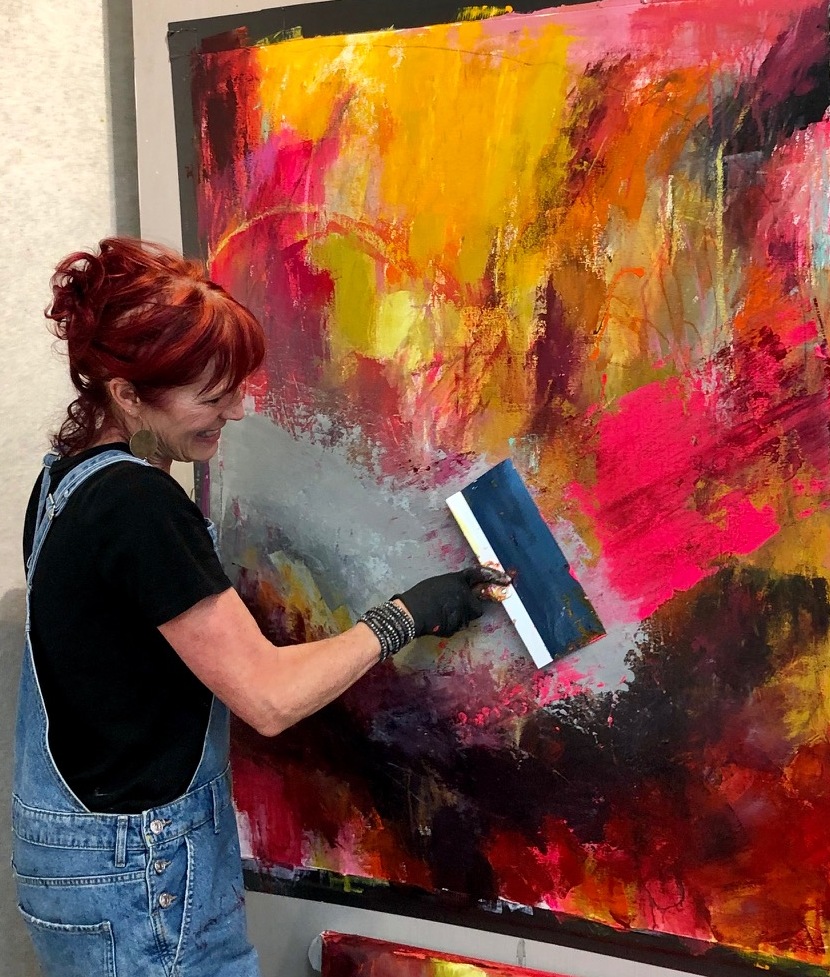
IH: I know you are an avid collector of discarded objects, which you then use in your art. What are some of your favorite pieces you’ve used in the past, and how did you go about picking them?
DC: The picking of found objects is one of my favorite things. I have a couple of friends who I have “junked” with over the years, whether on road trips, or seeking out flea markets. As for picking objects, I look for rust and patina, objects that have been well-loved and used. It is nice if the pieces are cheap, but sometimes if I find just the right piece, I am willing to pay a little more. I am a pretty avid collector, whether for displays in my home, or for use in my art. Hose nozzles, world globes, creepy doll heads, vintage rosaries, disintegrating old books, the list is embarrassingly long.
IH: What do you want people to know about your work?
DC: I would love for people to see joy and a sense of playfulness in my art, a reflection of how I view and live my life. I want the titles for my art to be ambiguous enough for the viewer to make their own interpretation, without me telling them what they should see or how they should feel, but rather, through color and how I make my marks, they experience a response that resonates with them.
While staying at The Independence Hotel, we recommend finding Dayna’s three pieces and getting a photo next to each of them. Then, follow Dayna on Instagram, to see her constantly evolving work, find out about her shows, and get a peak into her creation process!

